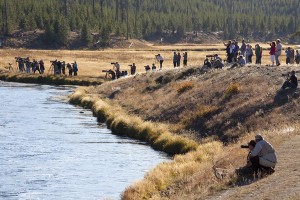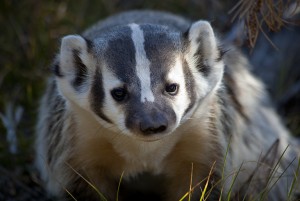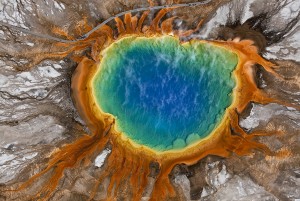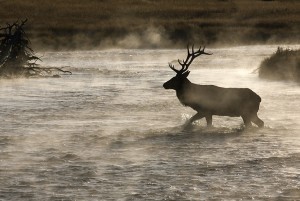In October 2011, I went on a “Photo Safari” set up by Rich Clark, a good friend and a fine photographer from Indianapolis, Indiana. http://www.richclarkphoto.com to The Grand Tetons and Yellowstone National Parks.
It is high season at these parks during this time of year, as fall color is happening in the Tetons, and elk and moose are in the meadows during their rutting seasons.
 “High Season” means that these parks are populated with human beings as well, of which many are photographers. Most of these are serious amateur photographers with expensive telephoto lenses and tripods. There are so many, that one does not need to look for wildlife along the main roads, all one needs to do is come across the traffic jams that the wildlife sightings create.
“High Season” means that these parks are populated with human beings as well, of which many are photographers. Most of these are serious amateur photographers with expensive telephoto lenses and tripods. There are so many, that one does not need to look for wildlife along the main roads, all one needs to do is come across the traffic jams that the wildlife sightings create.
Rich mentioned that quite a few National Park Rangers become attracted to the job because they would ostensibly be working with wildlife, but at these two parks their real job during this time of year is directing traffic around the wildlife sightings. We did find all the Rangers and park employees that we met to be very engaging with park visitors, and extremely outgoing, friendly and knowledgeable.
The animals that you see in these parks are not tame – note the two deaths this year in Yellowstone NP were attributed to bears – however they are habituated to coexisting with humans. This is especially true at Mammoth Hot Springs where the elk have learned that the manicured grass in town is better eating than the scrub in the hills, so every evening they come to feed.
The famed terraces at Mammoth Hot Springs have been deposited by the calcium-carbonate Terrace Mountain Spring over many years but, due to recent minor earthquake activity, the spring vent has shifted, rendering the terraces dry. Not so good for photography.
http://en.wikipedia.org/wiki/Geothermal_areas_of_Yellowstone 
As photographers, we worked from 5:00 AM until well after sundown and did have some magic moments, such as finding this badger in Yellowstone. We were able to make interesting photographs in spite of the number of photographers and the fact that on this trip we did not hike any trails or backpack to the interior of the parks. We stayed mostly on the main roads.
 A highlight was to photograph the Grand Prismatic Geyser from the air. This image has been taken by a number of photographers over the years – rendering it a bit of a cliché, but it was a great sight from the air, and we were able to make an interesting photograph from the plane. It felt very strange to be in the aircraft at high noon, as most of the time photographers are airborne in the early morning or late evening, using the shadows to provide dimensionality to the picture. But here, we didn’t want any shadows cast across the geyser basin.
A highlight was to photograph the Grand Prismatic Geyser from the air. This image has been taken by a number of photographers over the years – rendering it a bit of a cliché, but it was a great sight from the air, and we were able to make an interesting photograph from the plane. It felt very strange to be in the aircraft at high noon, as most of the time photographers are airborne in the early morning or late evening, using the shadows to provide dimensionality to the picture. But here, we didn’t want any shadows cast across the geyser basin.
After this trip I understand why the great nature photographers are reluctant to reveal the exact locations of their subjects.
